Table of Contents
- Introduction: Why Classroom Decor Matters
- Foundational Principles of Effective Classroom Design
- Section 1: Welcome & Entryway Decorations Ideas
- Section 2: Bulletin Board Brilliance: Creative Classroom Decorations Ideas
- Section 3: Wall Wonders: Maximizing Vertical Space
- Section 4: Ceiling and Lighting Decorations Ideas
- Section 5: Themed Classroom Decorations Ideas for Every Grade
- Section 6: Seasonal & Holiday Classroom Decorations Ideas
- Section 7: DIY Classroom Decorations on a Teacher’s Budget
- Section 8: Student-Created Decor: Fostering Ownership and Pride
- Section 9: Organizing with Style: Functional Classroom Decor Ideas
- Section 10: Inclusive and Calming Classroom Decorations Ideas
- Trending FAQs About Classroom Decorations Ideas
- Conclusion: Your Year-Round Decoration Roadmap
Introduction: Why Classroom Decor Matters
A classroom is more than just four walls and a whiteboard. It’s a second home for students and teachers for a significant portion of the year. The environment in which learning takes place has a profound impact on student engagement, motivation, and overall academic success. Effective classroom decorations ideas are not merely about aesthetics; they are a powerful teaching tool. A well-decorated classroom can stimulate curiosity, reduce anxiety, reinforce learning objectives, and build a strong, positive classroom community Classroom Decorations Ideas.
This ultimate guide is packed with thousands of creative classroom decoration ideas designed to inspire educators, from first-year teachers to seasoned veterans. We will explore everything from grand thematic designs to simple, affordable classroom decor hacks. Whether you’re looking for modern classroom ideas or timeless strategies, our goal at CozyNestDecor is to provide you with the inspiration and practical steps to transform your space into a cozy, organized, and inspiring nest for learning. Let’s dive in!
Explore our blog for more inspiration on creating cozy spaces at home and school.
Foundational Principles of Effective Classroom Design
Before we jump into the specific classroom decorations ideas, it’s crucial to understand the core principles that make a classroom design successful. Keeping these in mind will ensure your decor is both beautiful and beneficial. For more inspiration, explore our Classroom Decorations Ideas blog where we share practical tips and creative solutions.
Principle 1: Purpose Over Clutter
The goal is not to cover every inch of space. Every item you display should have a purpose. Is it educational? Motivational? Organizational? Visual clutter can be overstimulating and distracting. Choose quality over quantity Classroom Decorations Ideas.
Principle 2: Student-Centered Spaces
The classroom belongs to the students. Their work should be the star of the show. Displaying student art, writing, and projects fosters a sense of ownership and pride. The best classroom decorations ideas often come from the children themselves Classroom Decorations Ideas.
Principle 3: Readability and Accessibility
Ensure that all text on posters, bulletin boards, and labels is large, clear, and easy to read from anywhere in the room. Anchor charts and learning aids should be placed at student eye level to support engagement. For more creative classroom decorations ideas, check out our detailed guide on classroom decorations ideas.
Classroom Decorations Ideas
Principle 4: Incorporate Cozy and Calm Areas
Not all learning is loud and collaborative. Create a quiet corner with soft seating, calming colors, and perhaps a small library. This supports students who need a break and promotes social-emotional learning. For more on this, check out our guide Classroom Decorations Ideas.
Principle 5: Flexibility and Adaptability
Your classroom should be able to evolve throughout the year. Use movable furniture and decor elements that can be easily changed to suit different activities, units, or seasons Classroom Decorations Ideas.
Section 1: Welcome & Entryway Decorations Ideas
The classroom door and entryway set the tone for the entire day. A warm, inviting entrance makes students feel excited to enter and signals that this is a special place Classroom Decorations Ideas.
Themed Classroom Doors
Your door is a giant canvas for creativity. DIY classroom decorations for doors can be incredibly impactful.
- “Under Construction” Theme: At the start of the year, use yellow caution tape, hard hats (paper cutouts), and a sign that says, “Our Minds are Under Construction!”
- Literacy Themes: Decorate like a favorite book cover. The Magic Treehouse, Charlotte’s Web, or Where the Wild Things Are are perfect for this.
- Welcome Aboard: Create a rocket ship, submarine, or pirate ship doorway, inviting students on a year-long adventure.
Interactive Entryway Bulletin Boards
Place a bulletin board right outside or just inside the door with an interactive element.
- Question of the Day: Pose a fun question (e.g., “Would you rather have a pet dinosaur or a robot?”) and have students place a Velcro-backed name tag under their choice.
- “Look Who’s Been Spotted!” Board: Use student photos and add fun accessories related to the current season or unit.
Personalized Welcome
Greet each student by name.
- Name Tag Gallery: Have each student decorate a pre-cut shape (star, leaf, puzzle piece) with their name on the first day. Display these prominently near the entrance.
- Welcome Sign: A large, beautiful sign that says, “Welcome to Our Class Family!” or “You Belong Here.”
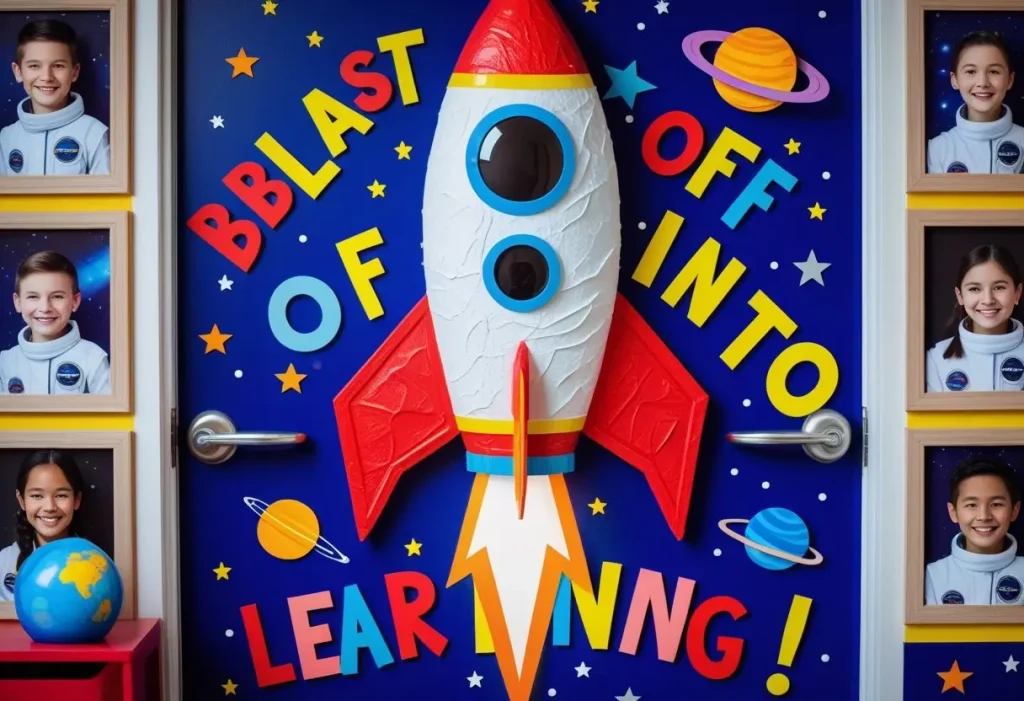
.
Section 2: Bulletin Board Brilliance: Creative Classroom Decorations Ideas
Bulletin boards are the workhorses of classroom wall decorations. They can be used to display information, celebrate success, and support instruction. For more inspiration and practical classroom decorations ideas, explore our guide to classroom decorations ideas.
The Main Instructional Board
This is your anchor chart central. Keep it organized and focused on current learning goals Classroom Decorations Ideas.
- Word Wall: A dedicated space for high-frequency words or vocabulary words. Use a large piece of felt or a pocket chart for words that can be easily added and removed.
- Math Focus Board: Display key math concepts, formulas, student-generated strategies, and a “Problem of the Week Classroom Decorations Ideas.”
Student Work Showcase Boards
This is where students shine. The goal is to display everyone’s work, not just the “best.”
- “Fridge Worthy” Board: Decorate a board to look like a giant refrigerator. Use magnetic tape to hold up student work. It gives a cozy, homey feel.
- Spotlight on Success: Use a spotlight cutout and rotate which student’s work is featured each week Classroom Decorations Ideas.
Interactive and Motivational Boards
These boards engage students directly.
- “We’re Building a Growth Mindset” Board: Create a brick wall background. Each time a student demonstrates a growth mindset (e.g., perseverance through a tough problem), they add a brick with their name and a brief description.
- “Caught Being Kind” Board: Encourage positive behavior by having students (or the teacher) write notes when they see an act of kindness. Pin the notes to a board with a giant heart Classroom Decorations Ideas.
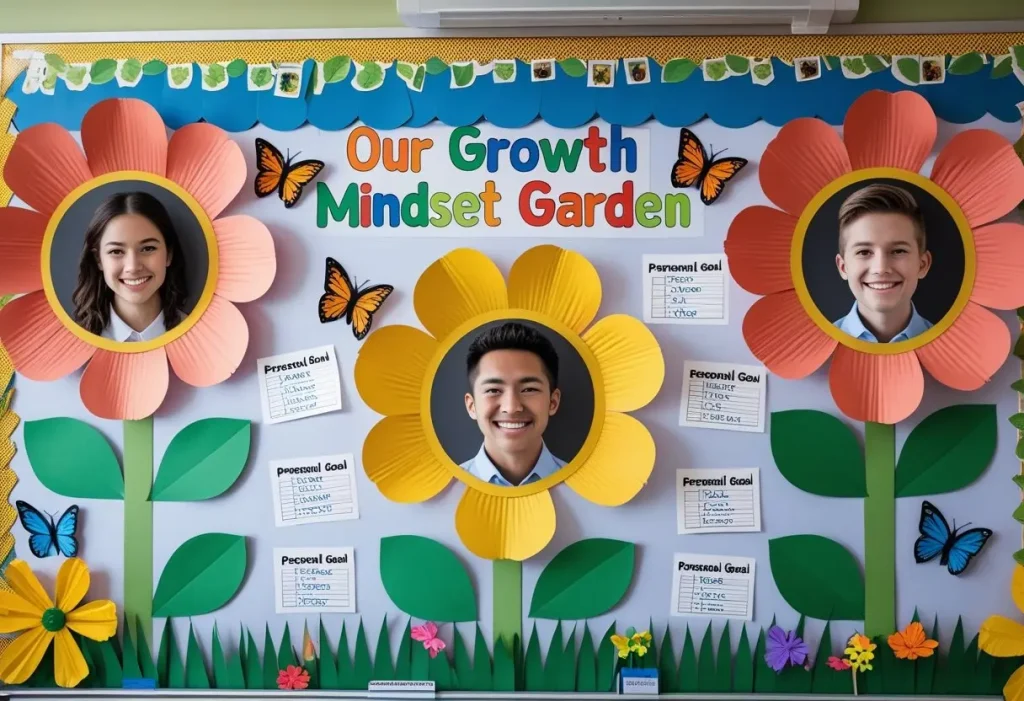
Section 3: Wall Wonders: Maximizing Vertical Space
Walls offer vast potential for educational classroom decorations. The key is to use this space strategically to avoid visual overload Classroom Decorations Ideas.
Anchor Charts and Learning Posters
Create these with your students during lessons. They serve as visual reminders of concepts taught.
- Reading Strategies: Posters on inferring, predicting, and visualizing.
- Writing Process: A clear, visual map of the steps from brainstorming to publishing.
- Scientific Method: A large, easy-to-follow chart for science inquiries.
Number Lines and Alphabet Displays
For younger grades, these are essential. Make them interactive!
- Human Number Line: Use photos of students holding numbers 0-20 (or higher!). It personalizes the display.
- Alphabet with Real Objects: Instead of just “A for Apple,” have a small shelf below the alphabet display with physical objects: a plastic apple, a real button for B, a car for C, etc.
Classroom Rules and Expectations
Display these positively. Instead of “Don’t run,” use “We use walking feet.” Use visuals or photographs of students modeling the expected behaviors.
Hall of Fame and Motivational Quotes
Create a dedicated wall space for celebrations and inspiration.
- “I Can” Statements: Frame statements related to learning objectives that students can achieve.
- Quote Wall: Use removable vinyl lettering to put an inspiring quote directly on the wall. Change it quarterly for a fresh feel.
Section 4: Ceiling and Lighting Decorations Ideas
Don’t neglect the “fifth wall”! The ceiling is perfect for hanging decorations that don’t take up precious wall or floor space.
Hanging Student Work and Mobiles
- Content-Related Mobiles: During a solar system unit, hang planets from the ceiling. For a poetry unit, hang student poems on colorful shapes.
- “Data Danglers”: Hang pieces of string from the ceiling and use clothespins to attach student work, creating a flowing gallery.
Themed Canopies and Fabric
- Reading Nook Sky: Drape blue fabric over a reading corner and add fluffy cloud cutouts and paper stars to create a serene sky.
- Jungle Vines: For a jungle or rainforest theme, hang green crepe paper vines and paper leaves from the ceiling.
Lighting for Ambiance
Harsh fluorescent lighting can be draining. Soften the room’s mood with alternative lighting.
- String Lights: Battery-operated fairy lights around bulletin boards or windows add a magical, cozy glow.
- Lamps: Place a few inexpensive floor or table lamps in corners to create pools of warm light. This is a simple affordable classroom decor trick with a huge impact.
- Paper Lanterns: Hang colorful paper lanterns in clusters at varying heights for a festive, modern look.
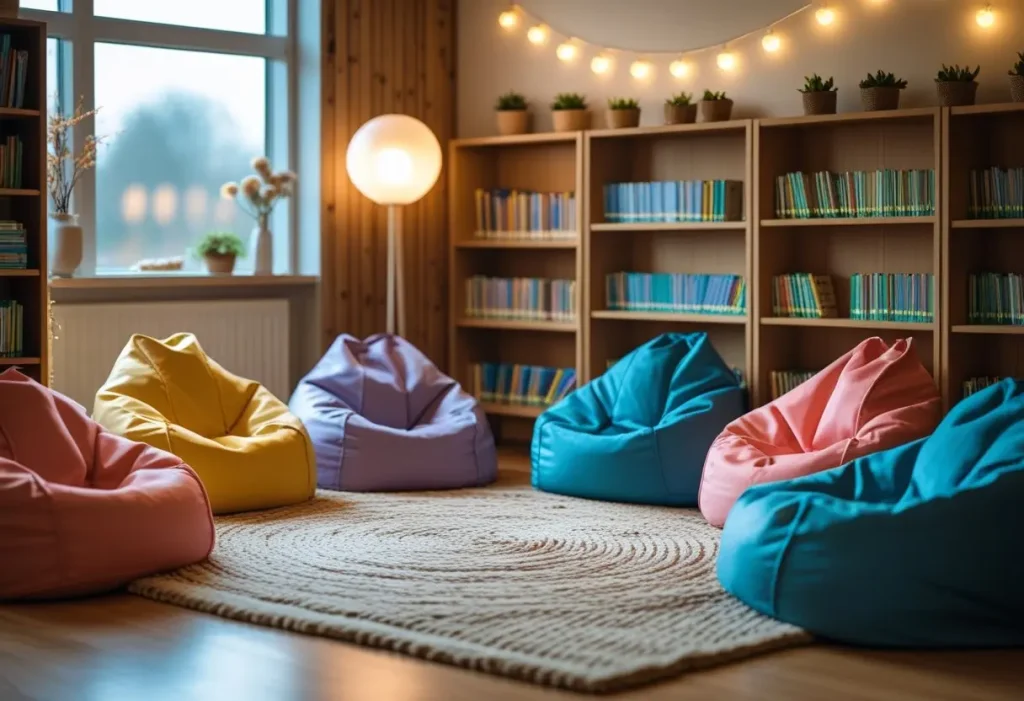
Section 5: Themed Classroom Decorations Ideas for Every Grade
A cohesive theme can make decorating easier and more fun. Here are themed classroom ideas for different grade levels.
Early Elementary (K-2): Adventure & Storybooks
- Theme: “Where the Wild Things Are” or “Magic School Bus”
- Decor Elements: Create a “classroom tree” in one corner using brown bulletin board paper for the trunk and green for the leaves. Turn your reading chair into a “magic bus” or a throne. Use lots of bright, primary colors.
Upper Elementary (3-5): Travel or STEM
- Theme: “Around the World” or “Innovation Lab”
- Decor Elements: A large world map on one wall. Suitcase cutouts for student goals. For a STEM theme, use gears, robots, and a “Mad Scientist” wall for science vocabulary.
Middle School (6-8): Modern & Motivational
- Theme: “Goals & Growth” or “Tech-Themed”
- Decor Elements: A more mature color palette (blues, greens, black). Use social media-inspired boards like a “Classroom Instagram” wall where students can post their best work. Focus on motivational quotes from relevant figures.
High School (9-12): Subject-Specific Themes
- English Class: A literary cafe theme with coffee-house-style seating and posters of famous authors.
- History Class: Decorate like a museum, with “artifacts” (replicas) and placards explaining historical events.
- Science Class: A laboratory focus with periodic table displays and famous scientist biographies.
Section 6: Seasonal & Holiday Classroom Decorations Ideas
Refreshing your decor throughout the year keeps the environment feeling new and exciting. Here are seasonal classroom decorations ideas that are easy to implement.
Fall & Autumn Ideas
- A Gratitude Tree: Cut a large tree trunk from brown paper. Have students write what they are thankful for on paper leaves and attach them.
- Pumpkin Patch Bulletin Board: Each student decorates a paper pumpkin to display.
Winter Ideas (Non-Holiday Specific)
- Snowflake Symphony: Decorate windows with unique, paper-cut snowflakes. Each student designs their own.
- “Our Class is Brighter than the Northern Lights”: Create a swirling, colorful display of streamers on a bulletin board.
Spring Ideas
- Growth Mindset Garden: Revisit the growth mindset theme with flowers. Each flower represents a student and their academic or personal growth.
- Butterfly Life Cycle: A beautiful, educational display that can be added to as you study metamorphosis.
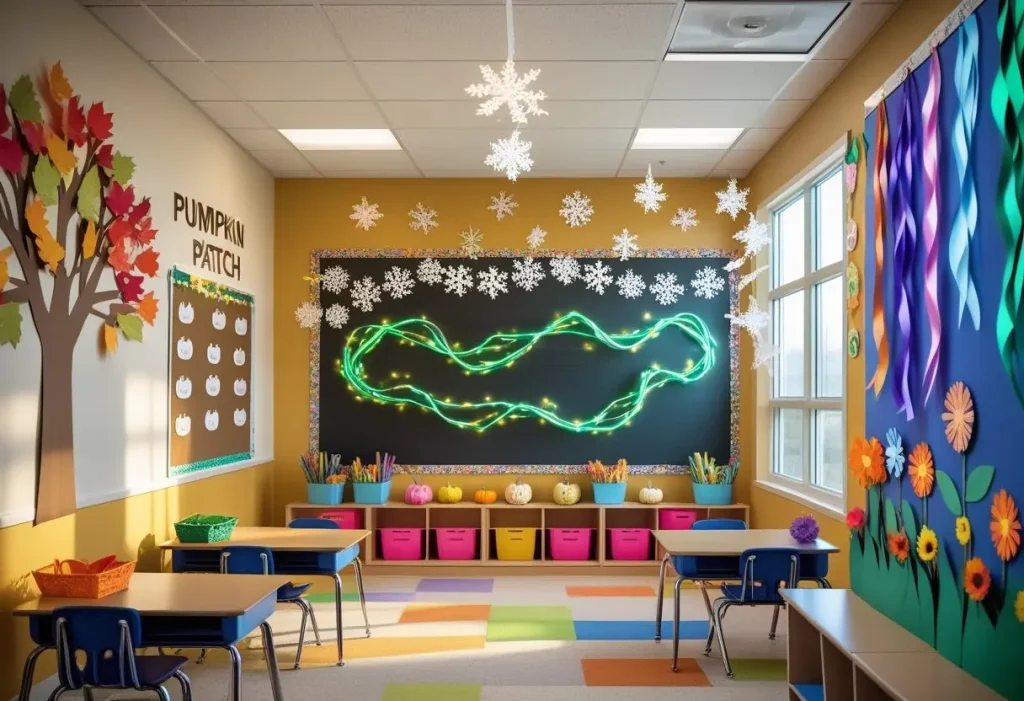
Section 7: DIY Classroom Decorations on a Teacher’s Budget
Teachers often fund their own classrooms. These DIY classroom decorations are high-impact but low-cost.
Upcycled Materials
- Bottle Cap Magnets: Collect plastic bottle caps, glue small magnets on the back, and use them to hold up student work on whiteboards.
- Crate Seating: Wooden or plastic milk crates can be stacked to create shelves or turned on their side and cushioned with a pillow to make seating. Check out our tutorial on [Internal Link: DIY crate seating for kids’ rooms].
Dollar Store Hacks
- Plates as Borders: Use colorful plastic plates as 3D borders for bulletin boards.
- Pool Noodle Frames: Cut pool noodles in half lengthwise and slide them over the edges of whiteboards or bulletin boards for a soft, colorful frame.
Digital Printables
There are thousands of free, high-quality printable posters, labels, and banners online. Print them at school or a local print shop and laminate for durability. This is a cornerstone of affordable classroom decor.
Section 8: Student-Created Decor: Fostering Ownership and Pride
The most meaningful classroom decorations ideas often come from the students. This saves you time and builds community.
- Collaborative Murals: At the start of the year, provide a large canvas or piece of paper and have every student contribute to a class mural.
- Goal Setting Banners: Each student creates a personal banner with their academic and personal goals for the year. String them together and hang them up.
- Learning artifact Displays: Instead of pre-made posters, have students create the anchor charts. Their language and examples will be more meaningful to their peers.
Section 9: Organizing with Style: Functional Classroom Decor Ideas
Organization is a form of decoration. A well-organized classroom is visually calming and efficient.
- Label Everything: Use a consistent font and color scheme for labels on bins, shelves, and folders. This supports literacy and independence.
- Color-Coded Systems: Assign a color to each subject (e.g., blue for math, green for science) or to each group of students. This simplifies transitions and management.
- Teacher’s Desk Area: Keep your space tidy and inviting with matching bins, a small plant, and a photo frame. A calm teacher space contributes to a calm classroom.
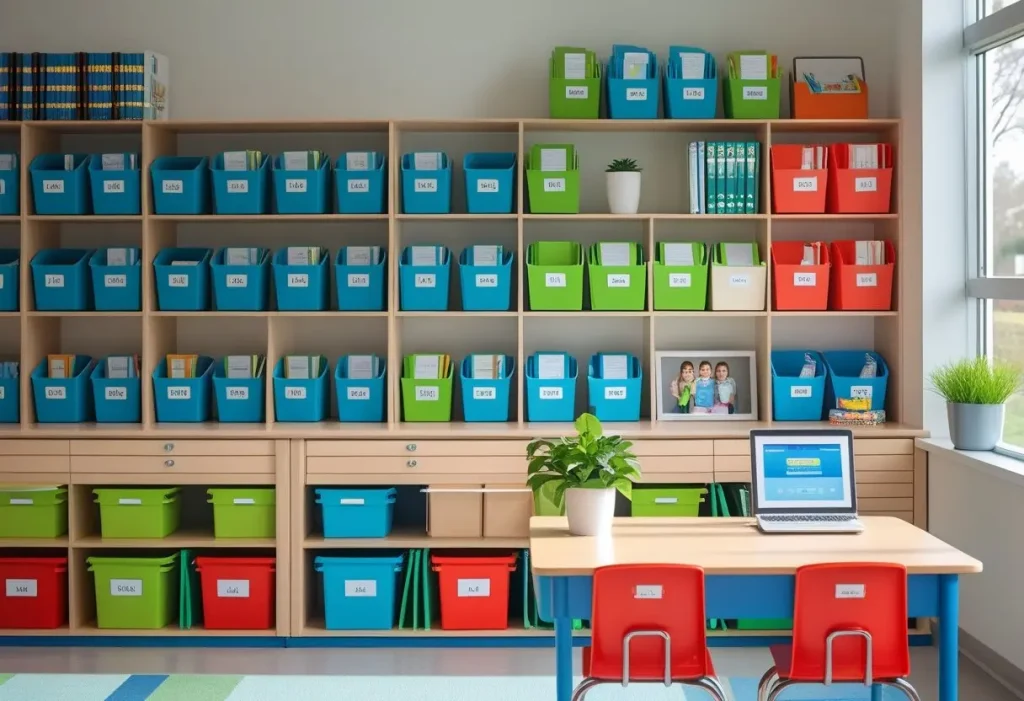
Section 10: Inclusive and Calming Classroom Decorations Ideas
An inclusive classroom supports all learners, including those with sensory sensitivities or anxiety.
- Neutral Color Palettes: While bright colors are fun, balancing them with neutrals like beige, gray, and soft blues can prevent overstimulation.
- Designated Calm-Down Corner: This is a must-have. Equip it with soft seating, noise-canceling headphones, fidget tools, and calming visuals (e.g., a glitter jar). For resources, [External Link: Understood.org] has excellent guides on creating sensory spaces.
- Visual Schedules and Timers: These decorations reduce anxiety by providing predictability. Use picture icons for younger students or digital timers that show the passing of time.
Trending FAQs About Classroom Decorations Ideas
1. What are some good classroom decorations ideas for a small classroom?
Maximizing a small classroom requires smart, multi-functional classroom decorations ideas. Focus on vertical space using tall, slim bookshelves and wall-mounted organizers. Use mirrors to create an illusion of space. Choose a light color palette for walls and furniture. Implement flexible seating that can be easily stacked or tucked away. Most importantly, avoid clutter by regularly editing what is on display. Every item should earn its place. [Keyword Variation: small classroom decor ideas]
2. How can I decorate my classroom on a very tight budget?
Affordable classroom decor is all about creativity. Utilize free resources like printable posters from educational websites. Embrace DIY projects using dollar store supplies, such as creating borders from paper plates or organizers from cardboard boxes. Upcycle materials—tin cans become pencil holders, and old frames become stylish menu boards for daily schedules. The most powerful and cost-effective resource is student-created art and anchor charts, which personalize the space at no cost.
3. What are the current trends in classroom decorations ideas for 2024?
Current modern classroom ideas for 2024 emphasize flexibility and well-being. Key trends include: Biophilic design (incorporating plants and natural elements), flexible seating options (wobble stools, floor cushions), neutral and calming color schemes with pops of color, and designated zones for different activities (collaboration, quiet work, comfort). Technology integration is also key, with spaces designed for charging stations and interactive displays. The focus is on creating a “home-like” feel that supports the whole child.
4. How do I create classroom decorations that are inclusive for all students?
Inclusive decor ensures every student feels safe and represented. Use visuals that reflect diverse cultures, abilities, and family structures. Incorporate multilingual labels if you have ELL students. Avoid overly stimulating patterns and bright colors that can be overwhelming; instead, create balanced, calm spaces. Provide flexible seating options to accommodate different physical needs. Most importantly, involve students in the decorating process to ensure the space reflects their identities and interests.
5. Where can I find inspiration for creative classroom decoration ideas?
Inspiration is everywhere! Pinterest and Instagram are fantastic visual platforms—search for terms like “creative classroom decoration ideas” or “themed classroom.” Teacher blogs and websites like [External Link: WeAreTeachers] offer endless practical ideas. Don’t forget to network with colleagues in your school or online teacher communities. Sometimes the best inspiration comes from your own students—ask them for their input!
6. How can I use classroom decorations to support student learning?
Decorations should be intentional teaching tools. Use word walls to build vocabulary, number lines to support math skills, and maps for geography. Display anchor charts that you create with students during lessons as visual reminders of concepts. Label shelves and bins to promote literacy and independence. Motivational quotes and student work displays can foster a growth mindset and build self-esteem, directly impacting their attitude toward learning.
7. What are some easy DIY classroom decorations for teachers who are not crafty?
Non-crafty teachers can still achieve amazing DIY classroom decorations. Focus on simple concepts: use washi tape to create geometric patterns on walls or desks, print and frame inspirational quotes, or arrange student photos in a large, pre-cut wooden letter (like the first initial of your last name). Using a consistent color scheme for store-bought bins and posters can also create a polished, cohesive look with minimal effort. Digital design tools like Canva make creating professional-looking labels and banners easy.
8. How often should I change my classroom decorations?
A good rule of thumb is to have a stable “core” and a rotating “peripheral.” Core decor (e.g., word wall, alphabet, classroom rules) should stay up all year for consistency. Peripheral decor (e.g., bulletin boards, doorway, seasonal items) can change with each unit, season, or holiday. This keeps the environment fresh and exciting without causing visual disruption or requiring constant, overwhelming work. Aim for a major refresh every 2-3 months.
9. How can I organize classroom supplies with decorative flair?
Organization is part of decor! Use color-coded bins for different subjects or student groups. Label everything with a clear, consistent font—consider using pictures for younger grades. Repurpose attractive containers like mason jars for pens and pencils, or woven baskets for notebooks. Turning organization into a display, like having art supplies visible in clear jars on a shelf, can be both functional and aesthetically pleasing.
10. What are some classroom wall decorations ideas that aren’t bulletin boards?
Walls offer vast potential beyond bulletin boards. Use removable vinyl decals for quotes or shapes—they add impact without damaging paint. Hang clipboards to create an easy-to-change display for student work. Suspend student artwork from clothespins on a string stretched across the wall. You can also create a “wall of fame” with framed photos of student accomplishments or a large world map for interactive geography lessons.
11. How do I choose a color scheme for my classroom?
Choose a color scheme based on the mood you want to create. Calming colors like light blues, greens, and neutrals are excellent for reducing anxiety and promoting focus. Energetic colors like yellow and orange can be used as accents to stimulate creativity and joy. Many teachers choose 2-3 main colors and 1-2 accent colors to create a cohesive look. Test samples in your classroom’s natural light before committing.
12. What are the best classroom decorations for high school students?
High school classroom decorations ideas should feel mature and relevant. Subject-specific posters (e.g., famous authors, historical timelines, scientific diagrams) are effective. Create a “college and career corner” with information about pathways. Display student work prominently, especially projects and essays. Motivational quotes from figures in your field of study can be powerful. The decor should feel more like a professional environment than a elementary classroom.
13. How can I make my classroom decorations more interactive?
Interactive decor engages students directly. Create a “graffiti wall” with whiteboard contact paper where students can solve math problems or brainstorm ideas. Install a magnetic wall for word sorts or story sequencing. An “estimation station” jar where students guess the number of items inside is a fun weekly activity. The key is to create decor that students can touch, move, and contribute to.
14. Are there any classroom decoration ideas I should avoid?
Yes, avoid over-decorating, as too much visual stimuli can be distracting. Steer clear of decor that is purely decorative with no educational or community-building purpose. Avoid displaying commercial materials that don’t align with your curriculum. Be mindful of safety—don’t hang heavy items over student seating, and ensure pathways are clear. Lastly, avoid themes or decor that could be culturally insensitive or exclude any student.
15. How can I involve parents in classroom decorating?
Parents can be a great resource! At an open house or via a newsletter, ask for specific donations (e.g., empty frames, fabric scraps, plants). Host a “classroom beautification day” where parents can help with larger projects like building a reading loft or painting a mural. You can also send home simple kits for parents and students to work on together, like decorating a puzzle piece that will become part of a whole-class display.
Conclusion: Your Year-Round Decoration Roadmap
Transforming your classroom into an inspiring, welcoming, and effective learning space is a journey, not a destination. The best classroom decorations ideas are those that evolve with your students, reflecting their growth, your current lessons, and the changing seasons. Remember the core principles: keep it purposeful, student-centered, and organized.
Start small. You don’t need to do everything at once. Pick one area—perhaps the entryway or a main bulletin board—and apply the ideas from this guide. Most importantly, have fun with it! Your passion for creating a beautiful space will be contagious and will show your students how much you care.
Ready to start your classroom transformation? Explore more inspiring ideas and practical DIY guides right here on [Internal Link: CozyNestDecor.pro]. We’re dedicated to helping you create spaces that are both beautiful and functional. Share your own amazing classroom decorations ideas with our community by tagging us on social media!New chat